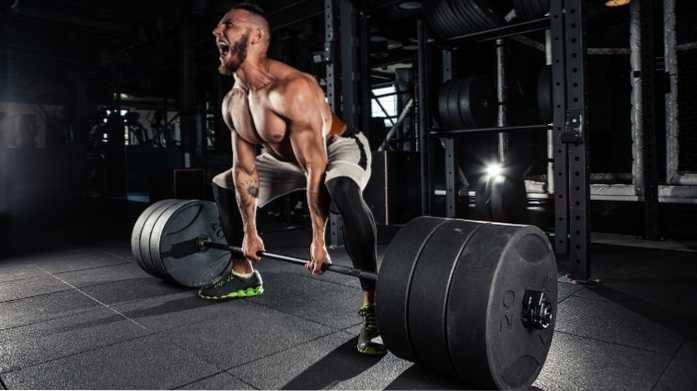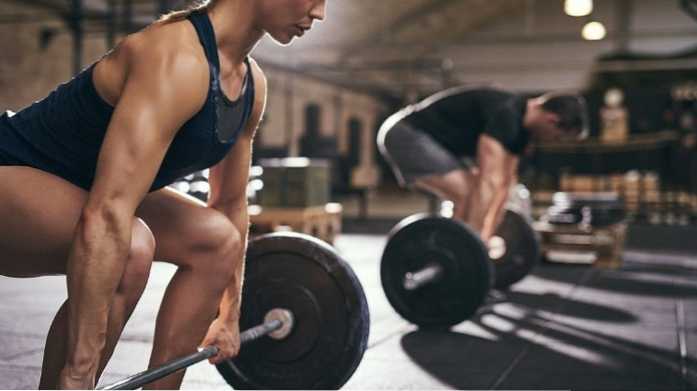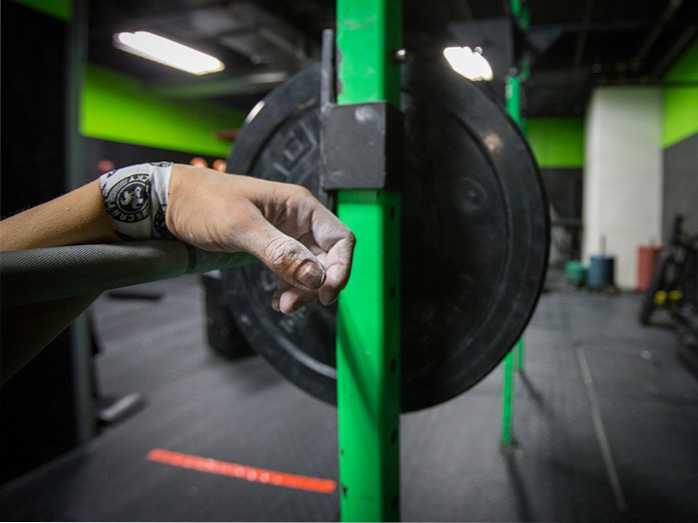
11 Deadlift Benefits That Are Backed By Science

If you're ready to take your strength, muscle mass, and athleticism to a whole another stratosphere, you'll want to include the king of all exercises into your training plan pronto. Of course, we're talking about deadlifts.
Not only is it a full-body movement that tests (and enhances) the strength and durability of your entire body, but it also has a plethora of benefits that will give you even more reasons to master them (aside from flocking your feathers once your strength surpasses all the other lifters in your gym).
To learn all the benefits incorporating deadlifts into your training plan will bring you, enjoy the rest of this science-backed article.
Benefits of Deadlifts
- More Strength
- Full-Body Activation
- Stronger Legs
- A Stronger Back
- More Calories Burned
- Releases Anabolic Hormones
- Better Core Strength
- Improved Athleticism
- Enhanced Endurance
- Better Posture
- More Grip Strength
Editor's note: The content on BarBend is meant to be informative in nature, but it shouldn't take the place of advice and/or supervision from a medical professional. The opinions and articles on this site are not intended for use as diagnosis, prevention, and/or treatment of health problems. Speak with your physician if you have any concerns.
More Strength
A 2018 review published in MOJ Yoga & Physical Therapy explored the benefits of performing squats, deadlifts, and bench press had on strength and overall health. It concluded that a physiological response of the deadlift was whole-body strength, power, and sports performance. (1)
Compared to other exercises that tax as many muscles as the deadlift, the deadlift lets you lift a lot of weight. You'll get stronger in a hip hinge position but also make neurological strength adaptations that carry over to other compound movements such as the bench press and barbell squats.

[Related: How to Build Your Own One-Rep Max Calculator]
It's a Full-body Workout
Although many people know that deadlifts work out your lower body, they also work out your upper body. Deadlifts engage your lower back, and upper back since those muscles support your torso as you pull weight from the floor. Your biceps will also be strained as they support your arms during the pull, and your shoulders will work hard to keep your arms locked into place.
The Deadlift Builds Stronger Legs
Deadlifts place a big emphasis on your lower body, including your glutes, quads, and hamstrings, resulting in strong and dense legs. Adding deadlifts to your training plan will take your leg strength to another level. One study found that subjects who did deadlifts twice per week for 10 weeks increased their rapid torque capacities in their knee extensors and flexors (aka quads and hamstrings), increasing their vertical jump. (2)
Build a Stronger, Less Injury-Prone Back
Having a strong lower back is important, especially as we age. Many people experience lower back pain due to a weak core, being overweight, and sitting behind a desk all day. Making deadlifts a part of your routine will help alleviate lower back pain and prevent it from developing in the future. Just be sure you keep your lower back straight throughout the movement. Rounding your lower back is a common cause of deadlift injuries and will increase your chances of injury.
The Journal of Strength and Conditioning Research indicated that deadlift training might help reduce pain and disability in some patients with low back pain. (3)
Deadlifts are a very functional movement, meaning they help out with a lot of everyday tasks. This will reduce the chances of you injuring yourself whenever your carrying groceries, changing a tire, moving home furniture, etc. Also, since you're getting a full-body workout in, you're strengthening your muscles and preventing muscular imbalances since you're making sure you work out both your upper and lower body.
You'll Burn More Calories
The deadlift works a lot of muscles in your body, which burns more calories during your workout. And the more calories you burn, the more fat you lose. Moreover, deadlifts help build muscle, increasing your basal metabolic rate (BMR) - the number of calories you burn at rest. A 2014 study performed by the European Journal of Clinical Nutrition found an average of a five percent increase in subject's metabolism after nine months of resistance training. (4)
They Release Anabolic Hormones
Since deadlifts recruit and stress many muscles, it causes the release of key anabolic hormones, such as testosterone and HGH. Having higher testosterone levels and HGH comes with a host of benefits, including more strength, muscle, energy, and improved libido. (5)
[Related: Everything You Need to Know to Build Your First Workout Program]
You'll Have Better Core Strength
When you do deadlifts, you rely a lot on your core's stability to lift the weight from the ground. Your core is also bracing hard to keep your spine rigid.
Actively bracing your core will make your core stronger for other exercises, including the bench press, overhead press, and single-leg deadlifts. Your core is responsible for facilitating movement, so having a strong core will carry over to everything you do.
Deadlifts Improve Athleticism
A 2011 study showed a link between core strength - which is bolstered by the deadlift -and improved athletic performance on a series of athletic tests, including the forty-yard dash, the T-test, vertical jump, and medicine ball throw. (6)
Another 2018 study by the Journal of Yoga and Physiotherapy reported that deadlifts might be more beneficial for horizontal-based sports movements that involve sprinting and jumping since a deadlift is applied to a perpendicular plane to the body but loaded in a horizontal plane. (7)
Enhanced Endurance
Although deadlifts are associated more with strength than conditioning, you can increase your muscular and cardiovascular endurance by increasing the number of reps and sets you do and decreasing the amount of rest in between sets. Since deadlifts tax so many muscles, you'll quickly find yourself keeled over after a few high-rep sets. The journal Sports Medicine found that deadlifts actually benefit the performance of endurance athletes. (8)

[Related: The Best Whey Protein Powders for Vegans, Weight Loss, and More]
Better Posture
Deadlifts improve your posture by keeping your shoulders, spine, and hips in alignment. Since deadlifts require proper form, you'll have to keep your shoulders squeezed back, spine straight, and hips mobile. Combined, these factors result in better posture. Improving your posture is vital as research shows that it can lead to back pain if left unfixed. (9)
You'll Develop a Stronger Grip
Deadlifts require immense amounts of grip strength to hold onto the weight during the movement. Since you're gripping heavy weights for a given rep range, you quickly increase your grip strength, which carries over into every exercise. Research indicates that grip strength is a solid biomarker for identifying older adults at risk of health problems. (10)
If you're not doing deadlifts to enhance your grip, you can use a pair of lifting straps to take your grip out of the equation.
How to Do Deadlifts
Now that you know all the benefits of adding deadlifts to your training regimen, let's look at how to perform deadlifts correctly. This is important. Although deadlifts have many benefits, they're an exercise you can easily hurt yourself on - specifically your back - if you aren't wary of using proper technique. Here's how to do it:
- Stand with feet shoulder-width apart, with your mid-foot underneath the barbell.
- Keep your back straight, hinge your hips, and bend over to grasp the barbell with a shoulder-width grip.
- Bring the barbell as close to your body as possible.
- Relax your neck and look straight ahead.
- Lift your chest, keep your shoulders protracted back, and maintain a straight back.
- Lift the weight - keeping the barbell as close to your body as possible - and fully extend your hips at the top of the movement.
- Slide the weight down your thighs back to the ground.
- Repeat.
[Related: The Best Barbells for CrossFit, Weightlifting, Powerlifting, Deadlifts, and More]
Deadlift Tips
Keep these three crucial tips in mind to maximize your performance and help prevent injury.
Protect Your Back
Please read this carefully and don't take it lightly: Try not to round your back while deadlifting. You don't want your thoracic spine (upper back) or lumbar spine (lower back) to round. If your back doesn't maintain a straight posture, you'll increase your chances of hurting your back and having to lay low from lifting for weeks, if not months. And that's no fun.
Performing accessory exercises that strengthen your back - like Pendlay rows and dumbbell rows - can help. Wearing a lifting belt will allow you to brace more effectively, too, for a more rigid torso.
Keep the Barbell Close to Your Body
When you lift and lower the barbell, you want to keep the barbell close to your body. If it's too far away from you, you risk hurting your back. Also, the torque of the barbell being further away from you won't allow you to use the most weight, which means you aren't maximizing your strength and muscle-building potential.
You literally want to slide the barbell up and down your shins throughout the movement, which is why you should own a nice pair of deadlift socks to protect you from deadlifts unforgiving scrapes. (Pro tip: some lifters wear knee sleeves around their shins to protect them from bruising.)
Fully Extend at the Top of the Movement
Many gym-goers forgo extending their torso, legs, and hips at the end of this exercise. Instead, they stop just shy of lockout. You're cutting yourself short if you don't fully extend at the top of deadlifts because you aren't fully engaging your quadriceps, hamstring, glutes, and back. Of course, fully engaging these muscles means more muscle mass and strength for your upper and lower body. If you compete in powerlifting, you need to extend your hips fully at the top of the rep for the lift to count.
Deadlift Variations
There are many deadlift variations that you can add to your training plan, depending on your goal. All deadlift variations will engage the same muscle groups in your posterior chain - back, arms, quads, glutes, and hamstrings - however, some target one muscle group more than the others.
Below are a variety of different deadlift options to try out next time you're in the gym.
Conventional Deadlift
The benefit of the conventional deadlift is that it works your back and hips more than other deadlift variations. The narrower stance forces you to engage your erector spinae, levator scapulae, and rhomboids more than other ones. Also, you'll be able to use a lot of weight on this deadlift variation.
[Related: The 10 Commandments of Deadlift Day]
Single-leg Deadlift
Although you won't be able to lift as much weight on single-leg deadlifts, you'll be able to improve your athletic performances since relying on one leg to pull the weight from the ground challenges your knee stability, core stability, hip stability, and balance. You have the option of using either a dumbbell, barbell, or kettlebell for this exercise. However, it's typically best to start with a kettlebell or dumbbell with this movement, especially for beginners.
Sumo Deadlift
Sumo deadlifts have you widen your stance and lift with your arms inside your legs (compared to outside of your legs for conventional deadlifts). The advantage of this stance is that it develops your legs - quads, hamstrings, glutes, adductors - more than conventional deadlifts. Also, since the wider stance allows you to stay more upright, you won't place as much stress on your back with sumo deadlifts as you will with conventional deadlifts. Many lifters find they can lift a little more weight in this position than the conventional deadlift due to the shortened range of motion.
[Related: Your Definitive Guide to Sumo Versus Conventional Deadlifts]
Trap Bar Deadlift
If you have any back issues or have poor hip mobility, you'll want to try deadlifts on a trap bar. This bar's hexagon shape allows you to better center your body and align your hips instead of having the barbell in front of you, which puts you at risk of hyperextending your hips. Also, the trap bar deadlifts place more emphasis on your anterior chain - quadriceps - than conventional deadlifts. Note: There are many great exercises you can do with the trap bar beyond just deadlifts.
Romanian Deadlift
The Romanian deadlift is similar to the conventional deadlift, except you won't lower the barbell all they back to the ground. Instead, you'll stop just below your knee at the top of your chins. This variation places less strain on your back and hamstrings since you'll have a lesser range of motion and a good alternative for hip mobility issues.
[Related: Romanian Deadlift Vs. Deadlift - Which is Best for Your Goals]
Stiff-Leg Deadlift
As the name suggests, stiff-leg deadlifts have you keep your legs as straight as possible when performing deadlifts. You'll only maintain a slight bend in your knees - to prevent hyperextending your knees - and you'll maintain that same bend throughout the entirety of the movement. Since knee flexion is minimal during this exercise, you'll target more of your posterior chain - glutes, hamstrings, and lower back.
Rack Pull
Also known as partial deadlifts, rack pulls are similar to traditional deadlifts, except you'll lift the weight with the barbell starting around knee height. The benefit of this is that the range of motion is shorter from a rack pull than other deadlifts, which focuses more on your upper back and traps, places less stress on your lumbar spine, and generally, powerlifters use it to increase the lockout phase of the deadlift. As an additional benefit, since the range of motion is shorter, you'll be able to use more weight to build more strength.
[Related: Are Rack Pulls Worth it? How to Do Them Correctly]
Final Word
Do you have to deadlift? No - of course not. But, deadlifts can help you build more muscle, increase strength, enhance your posture, and even improve athleticism. Before you do the movement, though, ensure that you perfect your deadlift form and take the necessary safety precautions.
Reference
- Vecchio LD, Daewoud H, Green S. The health and performance benefits of the squat, deadlift, and bench press. MOJ Yoga Physical Ther. 2018;3(2):40‒47. DOI: 10.15406/mojypt.2018.03.00042
- Thompson, Brennan J.; Stock, Matt S.; Shields, JoCarol E.; Luera, Micheal J.; Munayer, Ibrahim K.; Mota, Jacob A.; Carrillo, Elias C.; Olinghouse, Kendra D. Barbell Deadlift Training Increases the Rate of Torque Development and Vertical Jump Performance in Novices, Journal of Strength and Conditioning Research: January 2015 - Volume 29 - Issue 1 - p 1-10 doi: 10.1519/JSC.0000000000000691
- Berglund, Lars1,2; Aasa, Björn2; Hellqvist, Jonas1; Michaelson, Peter3; Aasa, Ulrika1 Which Patients With Low Back Pain Benefit From Deadlift Training?, Journal of Strength and Conditioning Research: July 2015 - Volume 29 - Issue 7 - p 1803-1811 doi: 10.1519/JSC.0000000000000837
- Aristizabal, J., Freidenreich, D., Volk, B. et al. Effect of resistance training on resting metabolic rate and its estimation by a dual-energy X-ray absorptiometry metabolic map. Eur J Clin Nutr 69, 831-836 (2015). https://doi.org/10.1038/ejcn.2014.216
- Shaner, Aaron A.1; Vingren, Jakob L.1,2; Hatfield, Disa L.3; Budnar, Ronald G. Jr1; Duplanty, Anthony A.1,2; Hill, David W.1 The Acute Hormonal Response to Free Weight and Machine Weight Resistance Exercise, Journal of Strength and Conditioning Research: April 2014 - Volume 28 - Issue 4 - p 1032-1040 doi: 10.1519/JSC.0000000000000317
- Sharrock C, Cropper J, Mostad J, Johnson M, Malone T. A pilot study of core stability and athletic performance: is there a relationship?. Int J Sports Phys Ther. 2011;6(2):63-74.
- Luke Delvecchio. The Deadlift -Part 1. J Yoga & Physio. 2018; 6(1): 555676. DOI: 10.19080/JYP.2018.06.555676
- Beattie, Kris & Kenny, Ian & Lyons, Mark & Carson, Brian. (2014). The Effect of Strength Training on Performance in Endurance Athletes. Sports Medicine. 44. 845-865. 10.1007/s40279-014-0157-y.
- Nowotny J, Nowotny-Czupryna O, Brzęk A, Kowalczyk A, Czupryna K. Body posture and syndromes of back pain. Ortop Traumatol Rehabil. 2011 Jan-Feb;13(1):59-71. English, Polish. doi: 10.5604/15093492.933788. PMID: 21393649.
- Bohannon RW. Grip Strength: An Indispensable Biomarker For Older Adults. Clin Interv Aging. 2019;14:1681-1691. Published 2019 Oct 1. doi:10.2147/CIA.S194543
Featured image: oleksboiko/Shutterstock



Nimeni nu a comentat acest articol încă.